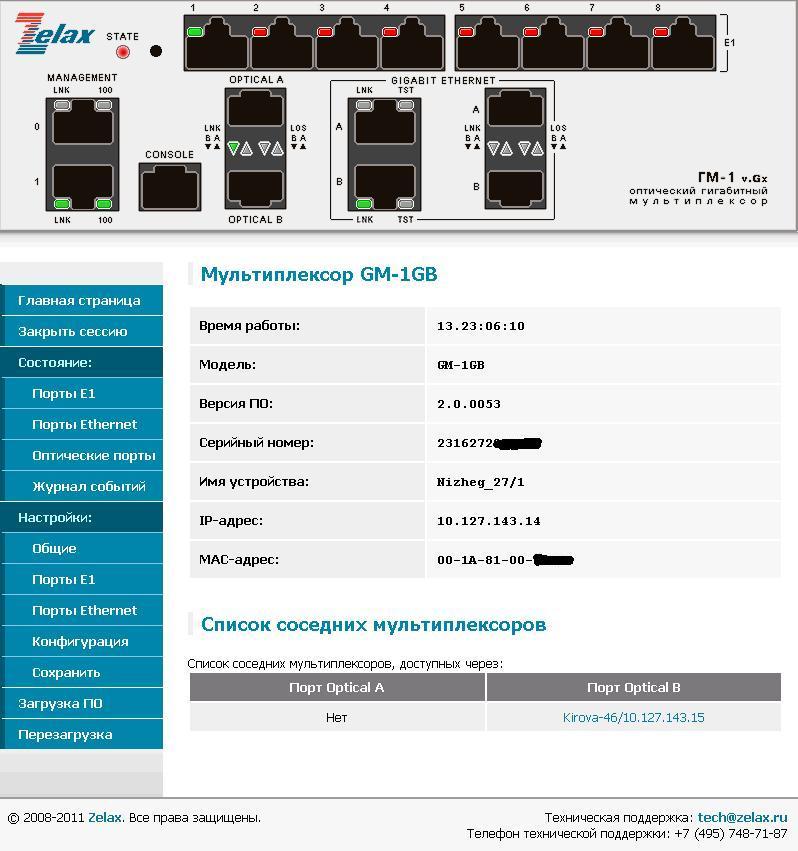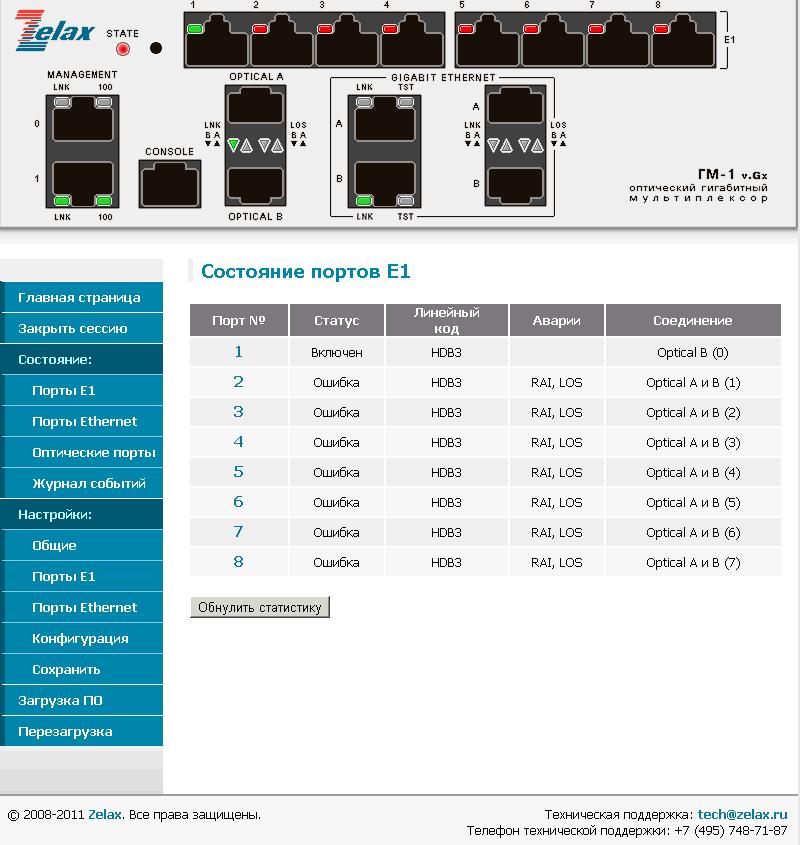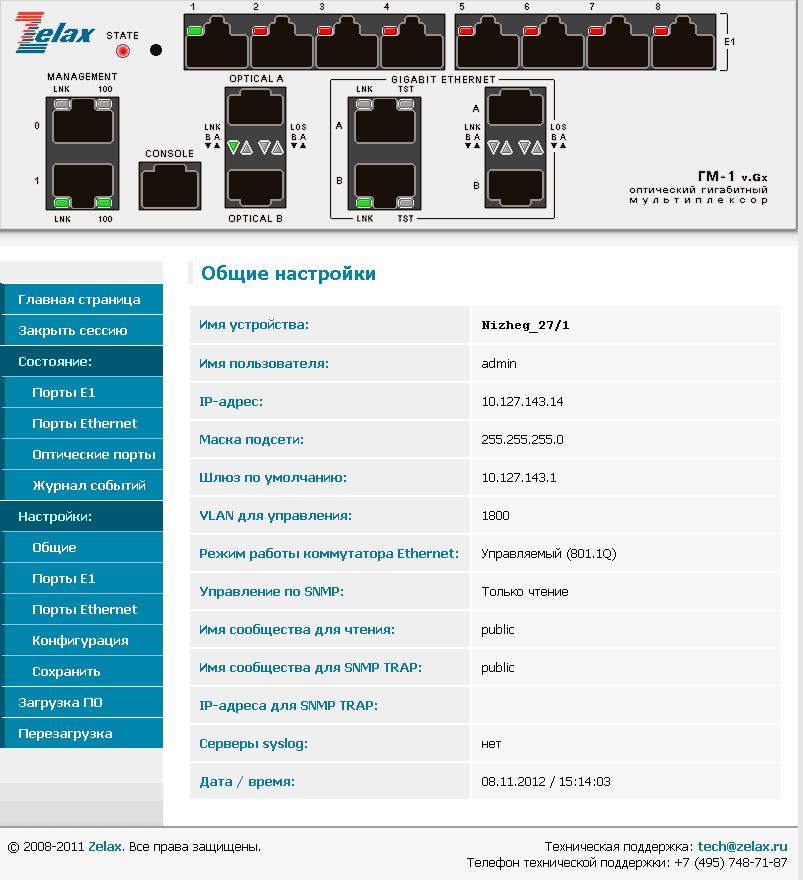Overview of the multiplexer Zelax GM-1GB
After the appearance of not very censorship proverbs and sayings about PolyComs (multiplexers used on L2 in our network), it was realized that it would not hurt to replace them with something less inclined to use folk folklore in support.
Caution! Under the cut a lot of pictures!
Two multiplexers were chosen for the tests:
1. Qtech QBM-P8M1GDS2 v1
2. Zelax GM-1GB-8E1
')
Qtech testing ended pretty quickly, because the sent CD with software didn’t have manual + a proprietary QNMS + chassis utility with a multiplexer stack occupied 3 units per rack needed for management.
Zelax, on the other hand, had an intuitive interface, which made it easier for support to diagnose problems, and did not take time for additional training.
Web interface:

The cap shows a view of the front panel of the multiplexer (about the display just below), at the bottom - a list of neighboring multiplexers (autodetection).
You can see the status of Ethernet ports, E1 and optics.



The state of the optical ports automatically determines the type of SFP module and the serial number, which also simplifies life for reporting.
Configuring E1 Ports:

Configure Gigabit Ethernet;

Well, the general settings of the multiplexer:

In the Configuration tab, you can backup, load a backup, restore factory settings, and save settings and statistics to a file.
To configure Zelax, it was necessary only to register IP and VLAN ( on the connected switches, VLAN should be forwarded ONLY with uplink, otherwise a ring occurs ), specify the “eye” (choice A or B), and set the transmission speed for Ethernet ports . By the way, if on one side costs 100 Mbps, and on the other 1000 Mbps, then Ethernet will not rise.
Indication:
State indicator in the upper left corner
green - everything is fine
red color - an error on any port
OPTICAL ports have two LNK and LOS indicators
LNK blinks if there is an optical signal. If it is absent, it is repaid.
LOS lights up briefly when errors occur. In the absence of an optical signal - not lit.
indication of E1 ports
green is normal
flashing green - test mode
red - LOS signal detected
flashing red - AIS signal detected
Gigabit Ethernet display
electrical ports
LNK is on - a Link signal is set on the port
LNK blinking - data transfer in progress
TST - not used
optical ports
LNK blinks - Link signal is set
LOS on - in the absence of an optical signal
LOS redeemed - in the presence of an optical signal
Port Management
LNK is on - Link signal is set
100 on - 100 Mbps speed
100 off - 10 Mbps speed
The main advantages of Zelax'ov:
- point-to-point and point-two points connections are possible, which allows you to put one Zelax instead of two PoliCom
- intuitive interface
- the most basic, for which, in fact, we thought about the issue of replacement - a significant reduction in losses.
For comparison, two pictures:
PolyCom monitoring (though not a very good pink color, but below you can see the number of drops in the optical link):

monitoring of the tested Zelax'a (there is already quite an adequate green color):

Minuses:
- Unlike PolyCom, which has dimensions 14x11x3.5, it occupies one unit in a rack.
- on the second test pair, for some reason, Ethernet did not rise in the “eye” A. The change of the “eye” to B helped.
- no telnet control
Caution! Under the cut a lot of pictures!
Two multiplexers were chosen for the tests:
1. Qtech QBM-P8M1GDS2 v1
2. Zelax GM-1GB-8E1
')
Qtech testing ended pretty quickly, because the sent CD with software didn’t have manual + a proprietary QNMS + chassis utility with a multiplexer stack occupied 3 units per rack needed for management.
Zelax, on the other hand, had an intuitive interface, which made it easier for support to diagnose problems, and did not take time for additional training.
Web interface:

The cap shows a view of the front panel of the multiplexer (about the display just below), at the bottom - a list of neighboring multiplexers (autodetection).
You can see the status of Ethernet ports, E1 and optics.



The state of the optical ports automatically determines the type of SFP module and the serial number, which also simplifies life for reporting.
Configuring E1 Ports:

Configure Gigabit Ethernet;

Well, the general settings of the multiplexer:

In the Configuration tab, you can backup, load a backup, restore factory settings, and save settings and statistics to a file.
To configure Zelax, it was necessary only to register IP and VLAN ( on the connected switches, VLAN should be forwarded ONLY with uplink, otherwise a ring occurs ), specify the “eye” (choice A or B), and set the transmission speed for Ethernet ports . By the way, if on one side costs 100 Mbps, and on the other 1000 Mbps, then Ethernet will not rise.
Indication:
State indicator in the upper left corner
green - everything is fine
red color - an error on any port
OPTICAL ports have two LNK and LOS indicators
LNK blinks if there is an optical signal. If it is absent, it is repaid.
LOS lights up briefly when errors occur. In the absence of an optical signal - not lit.
indication of E1 ports
green is normal
flashing green - test mode
red - LOS signal detected
flashing red - AIS signal detected
Gigabit Ethernet display
electrical ports
LNK is on - a Link signal is set on the port
LNK blinking - data transfer in progress
TST - not used
optical ports
LNK blinks - Link signal is set
LOS on - in the absence of an optical signal
LOS redeemed - in the presence of an optical signal
Port Management
LNK is on - Link signal is set
100 on - 100 Mbps speed
100 off - 10 Mbps speed
The main advantages of Zelax'ov:
- point-to-point and point-two points connections are possible, which allows you to put one Zelax instead of two PoliCom
- intuitive interface
- the most basic, for which, in fact, we thought about the issue of replacement - a significant reduction in losses.
For comparison, two pictures:
PolyCom monitoring (though not a very good pink color, but below you can see the number of drops in the optical link):

monitoring of the tested Zelax'a (there is already quite an adequate green color):

Minuses:
- Unlike PolyCom, which has dimensions 14x11x3.5, it occupies one unit in a rack.
- on the second test pair, for some reason, Ethernet did not rise in the “eye” A. The change of the “eye” to B helped.
- no telnet control
Source: https://habr.com/ru/post/157893/
All Articles